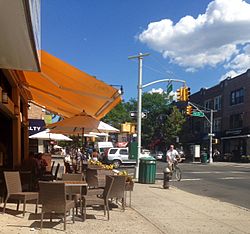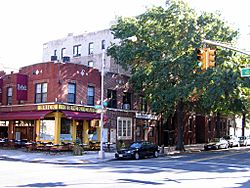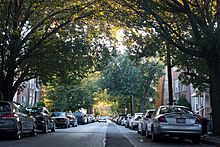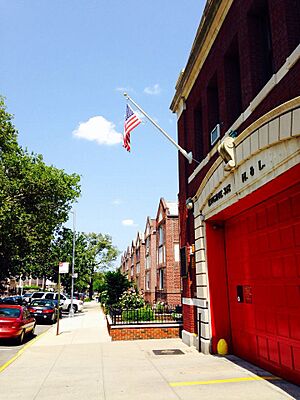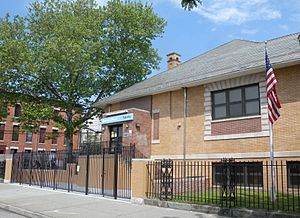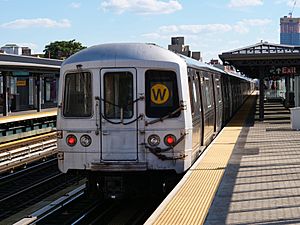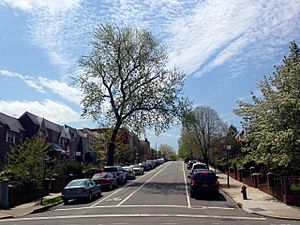Astoria, Queens facts for kids
Quick facts for kids
Astoria
|
|
|---|---|
|
Neighborhood
|
|
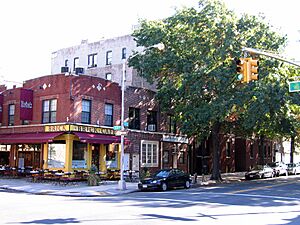
Corner of 31st Avenue and 33rd Street in Astoria
|
|
| Country | |
| State | |
| City | New York |
| County and borough | Queens |
| Community District | Queens 1 |
| European settlement | 1659 |
| Named for | John Jacob Astor |
| Population
(2010)
|
|
| • Total | 78,793 (154,000 with the subsections) |
| Ethnicity | |
| • White | 49.2% |
| • Hispanic | 26.5% |
| • Asian | 16.2% |
| • Black | 4.5% |
| • Other/Multiracial | 3.4% |
| Time zone | UTC−5 (EST) |
| • Summer (DST) | UTC−4 (EDT) |
| ZIP Codes |
11101–11103, 11105, 11106
|
| Area codes | 718, 347, 929, and 917 |
Astoria is a lively neighborhood located in the western part of Queens, one of New York City's five main areas called boroughs. It sits right next to the East River and borders other Queens neighborhoods like Long Island City and Sunnyside. As of 2019, about 95,446 people call Astoria home.
This area was first known as Hallet's Cove, named after William Hallet, who settled here in 1652. Later, in 1839, it was renamed Astoria to honor John Jacob Astor, who was the richest man in the United States at the time. People hoped he would invest in the area, and even though he only invested a little, the name stuck!
Astoria has some fun nicknames. It's called "Actoria" because many actors live here, thanks to its closeness to famous film studios like Kaufman Astoria Studios and Silvercup Studios. It's also known as "The Big Apple’s Fruit Basket" because of the many fruit trees, especially fig trees, growing in local yards.
Astoria is part of Queens Community District 1. Its ZIP Codes are 11101, 11102, 11103, 11105, and 11106. The New York City Police Department's 114th Precinct keeps the area safe, and the FDNY provides fire protection.
Contents
Exploring Astoria's Past
How Astoria Began
The land we now know as Astoria was originally called Hallet's Cove. It was named after William Hallet, who settled here in 1652. The area was surrounded by water, with Hell Gate to the north and the East River to the west.
In 1814, during the War of 1812, a fort called Fort Stevens was built here to protect the area. This fort and another defensive spot were the first permanent buildings in what would become Astoria. By 1836, a small village with about 20-30 homes and a church had grown, still called Hallet's Cove.
Wealthy New Yorkers started building large homes here in the early 1800s. Hallet's Cove became a popular spot for rich people from Manhattan to relax. On April 12, 1839, the village was officially formed. It was then renamed Astoria after John Jacob Astor, hoping he would invest in the area. Even though he never actually visited Astoria, the name remained!
Growth and Industry
In the late 1800s, more people moved to Astoria, especially German immigrants. Many of them were skilled furniture and cabinet makers. One famous example is Heinrich Engelhard Steinweg, who started the famous Steinway & Sons piano company in 1853. Today, Steinway pianos are known worldwide.
The Steinway family even built a special community called Steinway Village for their workers. It had homes, a sawmill, and even a streetcar line. This village offered schooling in both German and English.
In 1870, Astoria and other nearby villages joined to form Long Island City. Then, in 1898, Long Island City became part of the larger City of Greater New York. As the area grew, farms were replaced with houses and streets.
Astoria also played a big role in the early days of American filmmaking. Today, you can still see this history at the Museum of the Moving Image and Kaufman Astoria Studios.
Who Lives in Astoria?
Astoria is a very diverse neighborhood, meaning people from many different backgrounds live here. In 2010, the total population was about 154,141 people.
Over the years, the mix of people in Astoria has changed. Many different groups have made Astoria their home.
Diverse Communities
Astoria was first settled by people from the Netherlands, England, and Germany. Later, many Irish people moved here in the 1800s and early 1900s.
Then came many Italians, and you can still find lots of Italian restaurants, delis, and pizza places in Astoria today, especially around Ditmars Boulevard.
A large number of Jewish people also settled in Astoria. The Astoria Center of Israel, a historic synagogue, was built in 1925.
Starting in the 1960s, many Greeks moved to Astoria, and even more came after 1974. This is why you see so many Greek restaurants, bakeries, and churches. There's even a "Greek Town" area in Astoria!
Most of the Maltese people in New York City live in Astoria. There's a Maltese Center that helps support this community.
Since the mid-1970s, the number of Muslim residents has grown, including people from countries like Lebanon, Egypt, and Albania. A part of Steinway Street is even called "Little Egypt" because of the many Arabic shops and cafes there.
More recently, people from South America and the Balkan region (like Croatians, Albanians, and Brazilians) have also moved to Astoria. Many Spanish Americans, especially those from Galicia in Spain, also live here.
Astoria is known for being one of the most ethnically diverse neighborhoods in Queens. People from about 100 different countries live here, making it a truly global community!
Astoria's Layout and Areas
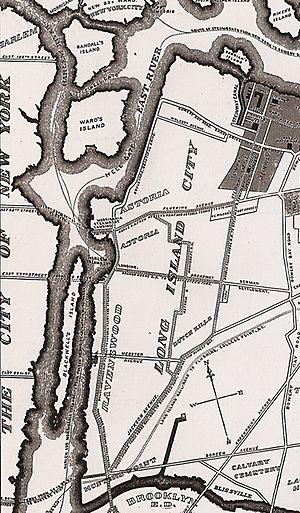
The exact borders of Astoria can be a bit tricky to define. Before 1898, Astoria was part of Long Island City.
Some areas within Astoria have their own names. For example, the eastern part of Astoria, around Steinway Street, is sometimes just called "Steinway." The northern part, near Ditmars Boulevard, is often called "Ditmars." Where they meet, it's sometimes known as "Ditmars-Steinway."
Ravenswood: A Historic Section
Ravenswood is a section of land along the East River that is part of Astoria. It was named either for the ravens that lived there or a character from a book.
In the early 1800s, a businessman named George Gibbs bought the land and started developing it. Later, some mansions were built, but these fancy homes didn't last.
Ravenswood never became its own village. In 1870, it joined with Astoria and other small towns to form Long Island City. By 1900, Ravenswood became a busy commercial area, and it still is today.
The name Ravenswood is also used for a large housing project built there in the 1940s and 1950s. It's also the name of a huge electric power station, the Ravenswood Generating Station, which provides about 20% of New York City's electricity!
Ditmars: A Residential Spot
Ditmars is a middle-class part of Astoria. It's bordered by Bowery Bay to the north and the East River to the west. The area is named after Abram Ditmars, who was the first mayor of Long Island City in 1870. His family were German immigrants who settled in the area in the 1600s.
Astoria Heights: Upper Ditmars
Astoria Heights, sometimes called Upper Ditmars, is a quiet, middle-class neighborhood. It's mostly made up of one- and two-family homes.
The Riker-Lent Homestead is a very old house in Astoria Heights, built around 1655. It's believed to be the oldest home in New York City still used as a residence!
The famous ragtime composer Scott Joplin is buried nearby at St. Michael's Cemetery.
Cool Places to Visit in Astoria
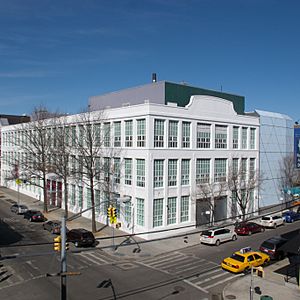
Astoria has many interesting places to explore:
- The Museum of the Moving Image is a great place to learn about movies, TV, and video games. It's located in the old Kaufman Astoria Studios building.
- The Isamu Noguchi Museum features amazing sculptures and gardens by the famous artist Isamu Noguchi.
- Socrates Sculpture Park is an outdoor museum where you can see large, modern art pieces right by the East River.
- Astoria Park is the biggest park in Astoria. It has the largest public swimming pool in New York City, which was even used for Olympic trials in 1936 and 1964!
- The Hell Gate Bridge is a huge, impressive bridge that crosses high above Astoria.
- The Bohemian Hall is the oldest beer garden in New York City, founded in 1910.
- The Greater Astoria Historical Society is a good place to learn about the history of the area.
- The Steinway & Sons piano factory has been making world-famous pianos in Astoria since the late 1800s. You can sometimes take tours of the factory.
- The Modern Art Foundry is where artists create sculptures using metal.
- Many historic buildings in Astoria are listed on the National Register of Historic Places, including the Astoria Center of Israel and the Steinway Mansion.
- The first xerography machine, which led to the invention of the Xerox copier, was created in Astoria in 1938 by Chester Carlson.
- Rainey Park is a nice park in the Ravenswood area.
Staying Safe in Astoria
The New York City Fire Department (FDNY) has four fire stations serving Astoria to keep everyone safe.
Mail and ZIP Codes
Astoria uses several ZIP Codes: 11102, 11105, 11106, 11101, and 11103. The United States Post Office has five locations in or near Astoria where you can send and receive mail.
Learning in Astoria
Astoria has many residents who have gone to college. About half of the people living here have a college degree or higher.
Students in Astoria generally do well in school. The percentage of elementary school students who are good at math and reading has improved over the years. Also, most high school students in Astoria graduate on time.
Schools in Astoria
The New York City Department of Education runs the public schools in Astoria.
There are also several private schools in Astoria, many of which are parochial schools (run by religious organizations):
- Immaculate Conception Catholic Academy
- Les Enfants Montessori School
- Our Lady of Mt. Carmel School
- Queens Lutheran School
- St. Catherine and St. George School
- St. Demetrios Astoria School
- St. Francis of Assisi School
- St. John's Preparatory School
- St. Joseph's Academy
- Most Precious Blood School
- El-Ber Islamic School
- The 30th Avenue School
- P.S. 70
- Horace Greeley I.S.10
- P.S./M.S. 122Q. Mamie Fay
Libraries in Astoria
The Queens Public Library has three branches in Astoria where you can borrow books, use computers, and find information:
- The Astoria branch
- The Broadway branch
- The Steinway branch
Getting Around Astoria
Public Transportation
Astoria is well-connected by the New York City Subway. You can catch the N and W train trains at several stations, including:
- 30th Avenue
- 36th Avenue
- Astoria Boulevard
- Astoria–Ditmars Boulevard
- Broadway
You can also take the M and R train trains from:
- 36th Street
- 46th Street
- Steinway Street
Many MTA Regional Bus Operations bus routes serve Astoria, helping people get around the neighborhood and to other parts of Queens and Manhattan.
Since 2017, NYC Ferry also has an Astoria route, offering a fun way to travel by boat.
There are also plans for a new light rail system called the Brooklyn–Queens Connector (BQX) that would run along the waterfront, connecting Astoria to Brooklyn.
Roads and Biking
Major streets running north and south in Astoria include Vernon Boulevard, 21st Street, 31st Street, and Steinway Street. Steinway Street is a busy shopping area.
Astoria has many bike lanes, which is great for cyclists. You can find marked bike lanes on streets like Vernon Boulevard and 21st Street. There are also paths that connect to the Triborough Bridge, leading to Randalls and Wards Islands.
Famous People from Astoria
Astoria has been home to many talented and well-known individuals!
Born in Astoria
- Ted Alexandro (born 1969), comedian
- Iris Apfel (1921–2024), businesswoman and style icon
- Joe Bastianich (born 1968), chef and restaurant owner
- Tony Bennett (1926–2023), Grammy-winning singer
- Robert Davi (born 1953), actor (from The Goonies, Die Hard)
- John Frusciante (born 1970), guitarist for Red Hot Chili Peppers
- Cyndi Lauper (born 1953), singer and songwriter
- Melanie Martinez (born 1995), singer-songwriter
- Ethel Merman (1908–1984), famous Broadway actress and singer
- Al Oerter (1936–2007), Olympic discus thrower (won four gold medals!)
- Dee Snider (born 1955), singer of the rock band Twisted Sister
- Christopher Walken (born 1943), Academy Award-winning actor
Lived in Astoria
- Lidia Bastianich, (born 1947) celebrity chef and TV host
- Chester Carlson (1906–1968), inventor of xerography (which led to Xerox)
- Jesse Eisenberg (born 1983), actor
- Whitey Ford (1928–2020), famous New York Yankees pitcher
- Chamique Holdsclaw (born 1977), basketball player
- George Maharis (1928–2023), actor and singer
Burial Sites
Astoria is the final resting place for some notable people at St. Michael's Cemetery. These include the ragtime composer and musician Scott Joplin. The cemetery sometimes holds concerts to celebrate Joplin's music.
Community Life in Astoria
Astoria has a very active community with many local events. Since 2020, the 31st Ave Open Street offers fun activities with local businesses and artists. "Shop Small Astoria" is a group of local stores that organize shopping and drink events in the neighborhood.
See also
 In Spanish: Astoria (Queens) para niños
In Spanish: Astoria (Queens) para niños


